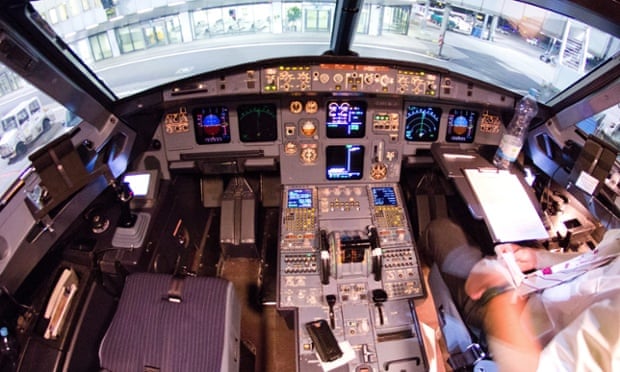http://www.theguardian.com/world/2015/mar/26/germanwings-crash-prompts-airlines-to-introduce-cockpit-rule-of-two Germanwings crash prompts airlines to introduce cockpit ‘rule of two’
Some airlines say they will change rules to ensure two crew are always in cockpit after Airbus A320 pilot is locked out before crash

The interior of the cockpit of the crashed Germanwings A320 aircraft with the identification number D-AIPX at the airport in Dusseldorf, Germany before it crashed in France. Photograph: Marius Palmen/EPA
Holly Watt
Thursday 26 March 2015 14.49 EDT Last modified on Thursday 26 March 2015 15.44 EDT
Some airlines are to change their rules to ensure two crew members are in plane cockpits at all times, after a co-pilot appeared to deliberately crash a Germanwings plane into the French Alps this week, killing all 150 on board.
Questions have been raised about the lack of a “rule of two” among European carriers after Andreas Lubitz, 27, apparently crashed the Airbus A320 on Tuesday while the captain was locked out of the flight deck.
Two low-cost European carriers – easyJet and Norwegian Air Shuttle – said on Thursday that they would bring the new rule into effect almost immediately.
“EasyJet can confirm that, with effect from tomorrow … it will change its procedure,” the airline said in a statement, adding that the decision had been taken in consultation with the UK’s Civil Aviation Authority.
Norwegian’s flight operations director, Thomas Hesthammer, said: “We have been discussing this for a long time but this development has accelerated things. When one person leaves the cockpit, two people will now have to be there.”
Air Canada and the Canadian charter airline Air Transat also said they would require two people to be in the cockpit at all times.
The CAA said it had asked all UK carriers to review procedures. “Following the details that have emerged regarding the tragic Germanwings incident, we are coordinating closely with colleagues at the European Aviation Safety Agency (EASA) and have contacted all UK operators to require them to review all relevant procedures,” a spokesman said.
A “rule of two” is routine among US carriers.
The US Federal Aviation Authority said in a statement: “US airlines have to develop procedures that the FAA approves. Those procedures include a requirement that, when one of the pilots exits the cockpit for any reason, another qualified crew member must lock the door and remain on the flight deck until the pilot returns to his or her station. A qualified crew member could be a flight attendant or a relief pilot serving as part of the crew.”
According to rules set out by the European Aviation Safety Agency, pilots must remain at their “assigned station” throughout the flight, “unless absence is necessary for the performance of duties in connection with the operation or for physiological needs”.
At this point, one pilot can leave the cockpit provided “at least one suitably qualified pilot remains at the controls of the aircraft at all times”.
French officials said Lubitz appeared to have locked his fellow pilot out of the cockpit before he deliberately crashed the plane. Emergency codes allow crew to enter a locked cockpit in the event of incapacitated pilots, but Lubitz would have been able to override it – a post-9/11 security measure intended to prevent hijack.
In a press conference after the tragedy, Lufthansa’s chief executive, Carsten Spohr, said the company had full trust in its pilots and those flying for its low-cost division, Germanwings.
“In a company like ours where we are so proud of our selection criteria, our safety criteria, this is even more of a shock for us than it is for the general public,” said Spohr. “We can only speculate on what might have been the motivation of the co-pilot.”
He defended the company’s policy of allowing one pilot to operate alone in the cockpit, saying that rival operators used the same system.
US airlines have different systems for minimising the risk to pilots while flying, which often involve using food carts as makeshift barricades.
“Every airline in the United States has procedures designed to ensure that there is never a situation where a pilot is left alone in the cockpit,” said a representative for the Air Line Pilots Association.